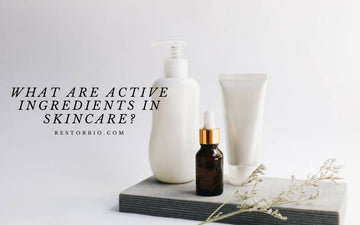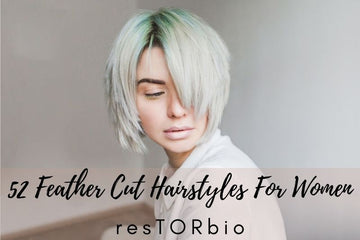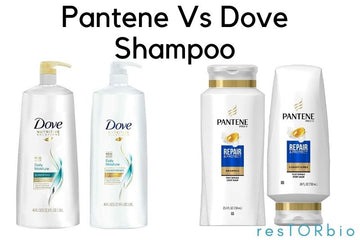
Active ingredients are the key to any skincare product. By definition, these are the ingredients in a skincare formulation responsible for delivering the product's therapeutic benefits. To determine whether a skincare product is right for you, it's essential to understand the active ingredients it contains. So, what are active ingredients in skincare? Below are a few of the most common active ingredients found in skincare products:
What Is an Active Ingredient?
It can be described as active ingredients, which are ingredients in beauty products that serve a purpose. They are ingredients that address a particular concern.

There are many types of actives available for skin issues. They can be used to treat sun damage, soothe, tend acne, moisturize, target fine lines, or protect against other forms of sun damage.
It becomes a little confusing when they are discussed in the context of beauty. The FDA-regulated "active ingredients" and then the more informal, more casual way it's used.
The FDA Definition of an Active Ingredient
According to the FDA, actives are considered topical drugs. "Any ingredient that the FDA classifies as a drug must be identified as active on the product label.
Hadley King M.D., a board-certified dermatologist, defines a drug ingredient as used to treat a chemical burn on the face from skincare or prevent specific conditions. Before active ingredients can be brought to market, the FDA must approve them for safety and efficacy.
My sunscreen is the most straightforward example I have. Look at the back of your label, and you will see a box called "active ingredient", which contains UV-blocking ingredients such as zinc oxide. It also lists the percentage of each ingredient. This is an excellent example of an FDA-approved active ingredient.

Active Ingredients as They Are Sometimes Called in Skin Care.
This language is used less frequently to describe ingredients that alter skin appearance. They are not FDA-regulated as they are cosmetic ingredients and not drugs.
These ingredients, which are often things like antioxidants and the like, can serve a purpose in the skin, but they don't come under the same scrutiny as drugs. They also don't need to be stated on the label.
This context makes it easy to explain active ingredients by using an example. Let's suppose you have been experiencing dark spots lately and decided to purchase a dark spot corrector.
These actives will contain whatever is intended to lighten or treat the marks. To get rid of the stain, you might find a mask with alpha-hydroxy acid.
A serum with vitamin C may be an excellent option to brighten the skin and combat free radicals. A retinol-based night cream may be a good option, promoting cell renewal and turnover. Each of these products has actives that target specific spots, but they do so in various ways.
Another example is if you are suffering from acne or are prone, you might look for a product that can help clear your skin.
These actives can be used to stimulate exfoliation, reduce inflammation, control oil production, or target acne-causing bacteria.
Again, there are many ingredients and products available. For example, a facewash may contain salicylic acid to reduce oily skin.
Another option is to use retinol, a standard component in night products. You might also look for soothing botanicals that target skin inflammation.
What Are Considered Active Ingredients in Skincare

Alpha Hydroxy Acid (AHA): The AHA family is made from natural sources like fruit, milk, and sugar. AHAs have many benefits for the skin, including exfoliation, brightness, smoothing, and anti-aging products.
Glycolic acid, which is derived from sugar, and lactic acid, made of milk, are the two most popular AHAs used in skincare.
Glycolic acid is unique because its molecules are smaller than other AHAs. This allows it to penetrate deeper into the skin, providing more benefits and reaching deeper layers.
However, the other AHAs offer the same benefits as the former but are non-friction exfoliants that dissolve dead skin cells and cause no skin irritation. Lactic acid can be used on sensitive skin.
Vitamin C: Vitamin C is an antioxidant that helps keep your skin young and vibrant. It protects your skin from harmful free radicals and neutralizes them.
This helps reduce the visible signs of aging on your face like fine lines, wrinkles, sun-damaged dark spots, loss of moisture, and sun-damaged skin.
Vitamin C's most prominent and well-known benefit is its ability to brighten and reduce discoloration. Vitamin C's antioxidant properties help out your skin, giving you a radiant glow.
Vitamin C can be temperamental and hard to store for extended shelf life. Therefore, it is essential to look for products that contain vitamin E or ascorbic acids.
This will help prolong its usefulness. Find out more about vitamin C, and add this powerful antioxidant to your daily skincare routine.

Hyaluronic Acid: Hyaluronic acids are a powerful ingredient. It has attracted much attention in recent years due to its anti-aging properties and intense moisturizing capabilities.
It is a sugar naturally found in the body and a key component of skin structure. As we age, our naturally produced levels of hyaluronic acids decrease, which leads to a reduction in skin volume and tone.
The visible effects of losing hyaluronic acids can be countered by topical application. Hyaluronic acid's ability to retain water and regulate skin moisture levels helps keep your skin hydrated and balanced.
Hyaluronic acid also improves skin resilience. These two functions work together to restore skin volume and fullness, which reduces the appearance of wrinkles and fine lines.
You might consider adding hyaluronic acids to your skincare routine. Learn more about the benefits of hyaluronic acids in our blog article
Retinol: A artificial derivative from vitamin A, retinol can be placed on the skin to convert it into retinoic acids. Because of its significant skin benefits, retinol is a crucial ingredient of many skincare products.
It helps to minimize the appearance of skin damage from free radicals and the visible signs and symptoms of aging. Retinol can help reduce the loss of facial fullness by increasing the skin's ability to retain moisture.
Your skin will look fuller and more hydrated if it is regularly used. Retinol can be used for extended periods to reduce the appearance of age spots. It also helps unclog pores and slough off dead skin layers. Find out more about retinol's benefits.
Salicylic Acid: Salicylic acids are members of the beta-hydroxy acid (BHA) family. They are a common ingredient in many over-the-counter acne treatments and products.
It is used to treat blackheads and inflamed skin conditions. It can also reduce excess oil and penetrate deeper into your pores to remove clogging debris.
Although it can be found in wintergreen and white willow bark, most salicylic acids used today are synthetic. To learn more, visit our salicylic acid health benefits article.
Ceramides: lipids found naturally in the skin, are an essential part of your skin's natural barrier that helps protect it from environmental stressors and retain moisture.
An imbalance in your skin's ceramide levels can lead to skin dryness, itching, and inflammation. Your natural levels of Ceramides can quickly be decreased by exposure to heat, soaps, chemicals, and other environmental factors. This is why products containing ceramides can be used to help rebuild the barrier and prevent further damage.
Niacinamide, a derivative of vitamin B3, effectively soothes skin irritations. Niacinamide can be applied to the skin to reduce irritation and redness caused by certain skin conditions.
It increases your skin's capacity to retain moisture while also increasing the effectiveness and protection of ceramides.
Vitamin E: Vitamin E is found naturally on the skin of humans, but vitamin E levels can be depleted by sun exposure and other environmental irritations.
It has antioxidant properties which can limit and prevent the damaging effects of harmful free radicals [12]. It can also stabilize volatile or temperamental ingredients, such as vitamin C.
Benzoyl Peroxide: Benzoyl Peroxide kills bacteria in your pores and is an effective acne treatment. Because bacteria cannot survive in an oxygen-rich environment, benzoyl peroxide reduces the risk of it happening.
Clearer pores mean fewer bacteria, which in turn leads to fewer breakouts. Benzoyl peroxide can cause the skin to dry out and disrupt the balance.
Sulfur is another effective ingredient in acne treatment. Sulfur is a chemical that works by drying the skin's top layer and then gently peeling it off your face.
This helps keep pores clear and encourages new skin layers. It has antibacterial properties that can be used to combat any lingering bacteria.

Where Do You Find Actives?
Many products contain active ingredients. These include cleansers, creams, and serums. You can find them at many price points, too; they are also both OTC or prescription-strength.
The outcome of the product can be affected by how the action is made, the percentage used, and the quality of the ingredients. While actives are available in many products, they're not all created equally.
Prescriptions that a dermatologist gives are the most powerful. These prescriptions, such as retinol and azelaic acids, benzoyl peroxide, and others, are formulated at such high percentages that professionals should monitor them and give them to those who require them. Most likely, if your skin problem warrants a visit to a dermatologist, one will be provided.
OTC products come in many forms. You can find serums and creams north of $500 at retailers or direct-to-consumer or you can find drugstore options that are decidedly less costly. It is also essential to consider the product type. Face washes tend to be cheaper than creams and serums.
The bottom line is that you can choose what OTC products to buy based on your needs, preferences, and budget. You may not be able to afford all the options available at your local drugstore.
Many good options can help your skin, including Alba Botanicals or Burt's Bees. You can also shop at department stores, Sephora, Credo, or other retailers for more options. These more expensive products may contain more vital actives or have more actives.
How To Choose The Right Active?

Understand Your Skin
It is crucial to understand your skin type before settling on an active ingredient. This skin test will help you determine your skin type.
Layering Actives
It would help if you used multiple actives in your daily routine. A rule of thumb is to use Vitamin-based actives during the day and AHAs/BHAs at night.
Make sure you use water-soluble ingredients first before oil-soluble ones. It is essential to determine the pH levels of products before applying them. The most acidic product should be applied first. Learn more about layering products on our blog.
Concentration
The concentration of active ingredients is a critical factor in determining their effectiveness. This is why it is essential to use the correct concentration if you are trying to treat a particular concern.
Always start slowly with actives. Follow the recommendations of dermatologists and label instructions. You can gradually increase the concentration once your skin is used to it.
Inactive Ingredients
Active ingredients can effectively manage skin problems, but paying attention to inactive ingredients is essential.
Patch Test
To rule out allergic reactions, it's a good practice to perform a patch test on any new ingredients or products you introduce to your skincare routine.
SPF
Your skin is more sensitive to the sun if active ingredients are added to your skincare. Always apply sunscreen before you go outside.
Our favorite is Dr. Sheth's Mineral Sunscreen, specifically formulated for Indian skin. It offers broad-spectrum protection against ultraviolet rays, blue light damage, and pollution.
What are Inactives?
Other than a pure ingredient, there are likely to be additives that aren't considered "actives" in your formula. These additives can be tempting to dismiss as filler. But they often serve a purpose.
Preservatives are available in the natural space. Look for phenoxyethanol and sea salt to identify them. These preservatives keep the formula safe from bacteria and mold for long-term usage. Preservatives can be used to stabilize your product so that it can last longer than its expected shelf life.
Some ingredients can improve absorption, such as propanediol which delivers the actives and enhances your senses.
There are also more well-known options, such as botanical oils, shea butter, and aloe vera, that can be used to make your product more complete.
Myths About Active Ingredients

Myth 1: It is essential to use products with multiple active ingredients for best results
Too many actives can cause skin irritation, so focus on one area at a time.
Myth 2: The longer you use a product with an active, the better it is for your skin
While some actives can be beneficial to the skin, they should not be permanent. However, actives that address specific skin issues should be phased out after they are finished. You can either switch actives to address other skin issues or bring back the activity if you are not satisfied with the results.
Myth 3: The majority of actives are synthetically derived and therefore not good for the skin
Each ingredient's effectiveness is dependent on its composition. Lab tests that prove each active ingredient's efficacy are used to determine this. No matter if they are synthetic or natural, safe and well-formulated ingredients will always work.
Myth 4: Skincare products must contain actives
It is OK not to include active ingredients in your skincare routine if you don't have a particular skin problem. Actives can be added to your skincare to treat a specific skin issue.
However, you don't have to use actives if you are happy with your current skincare routine. Multiple actives are not always better.
What Are the Active Ingredients in Absolute Skincare: Conclusion
Active ingredients are the heart of a skincare product. They are responsible for delivering most of the benefits that the product promises. Some active ingredients work to exfoliate the skin, while others hydrate it. We hope that our article can help you know what ingredients are suitable for your skin and how they work?




